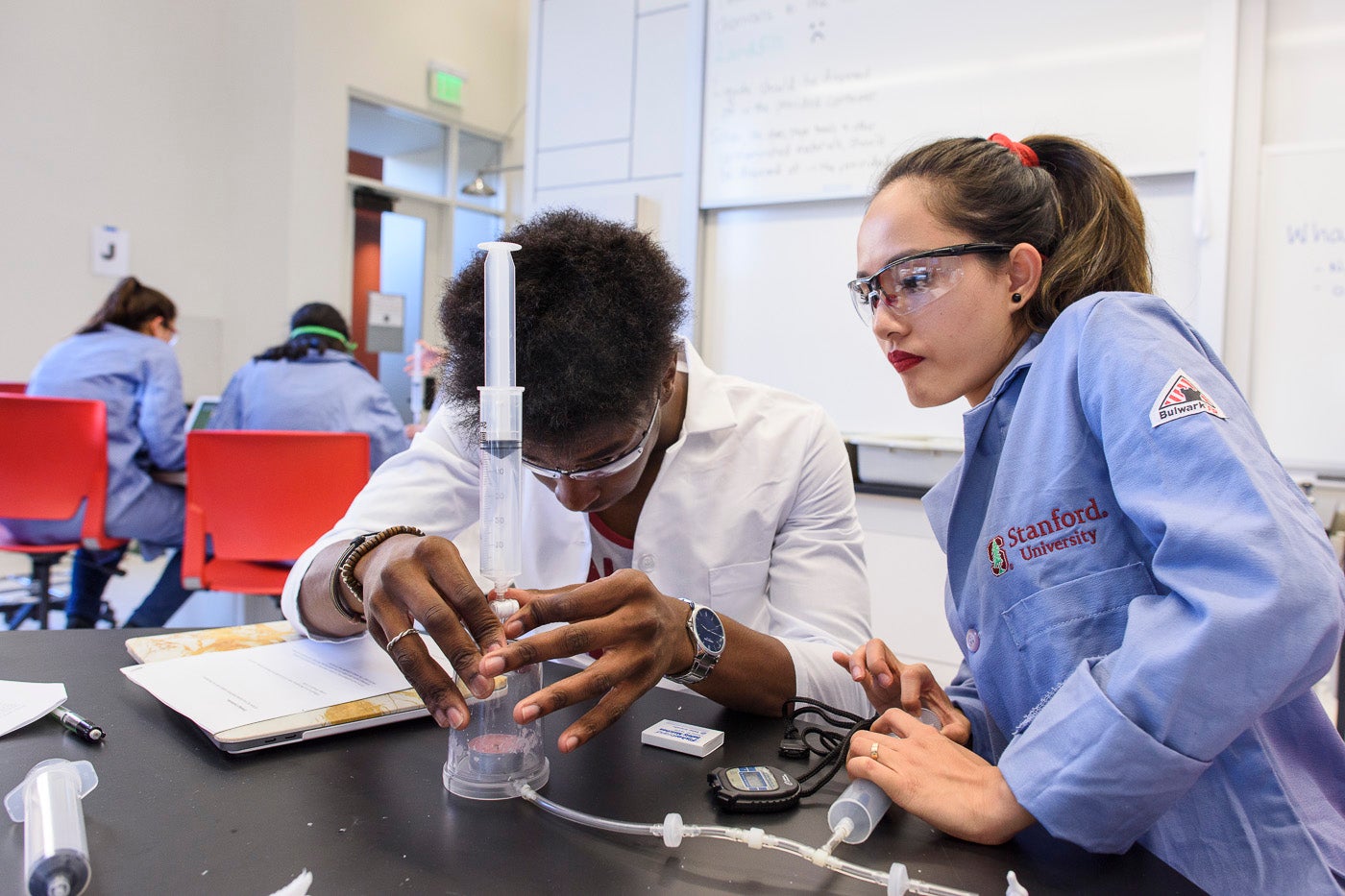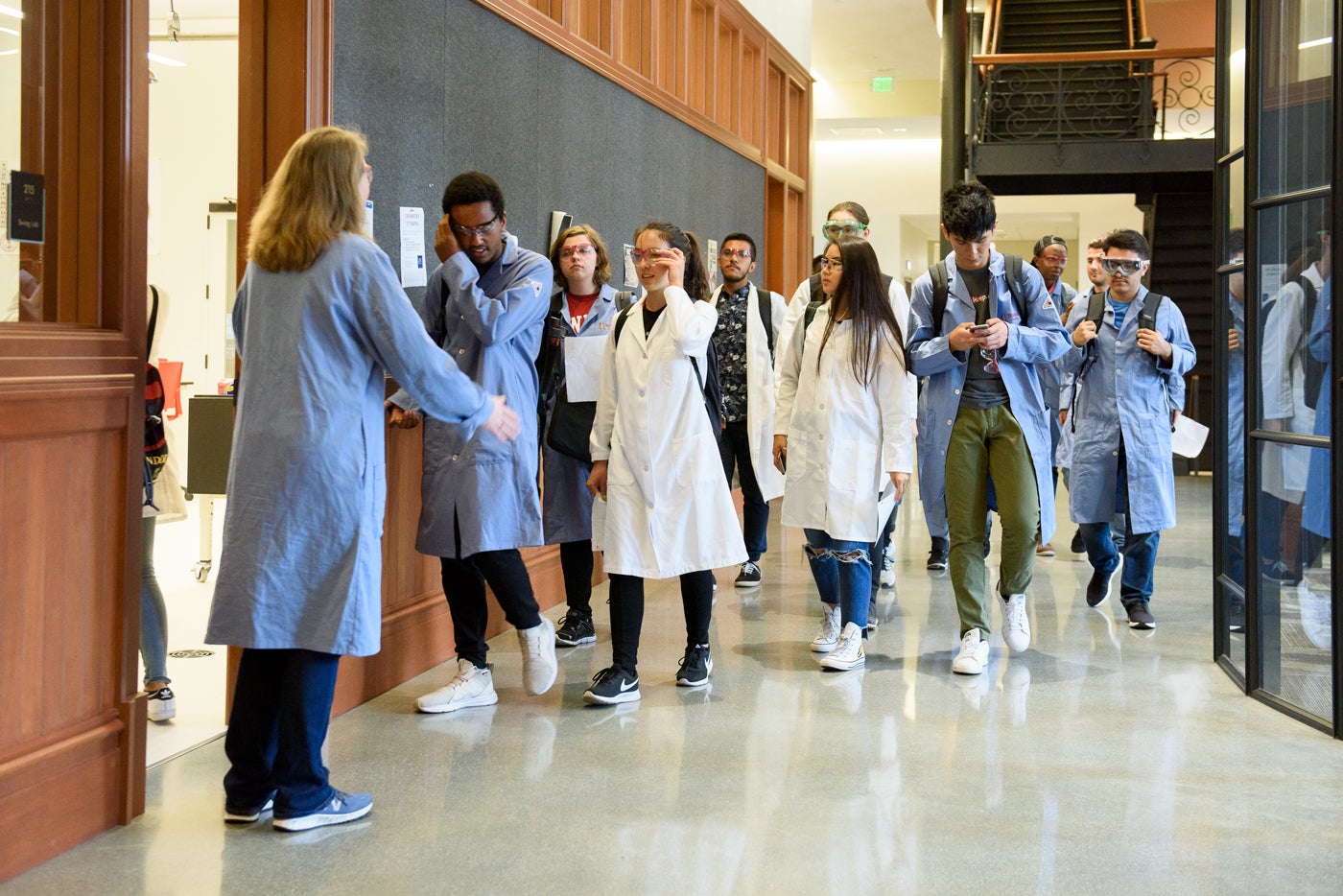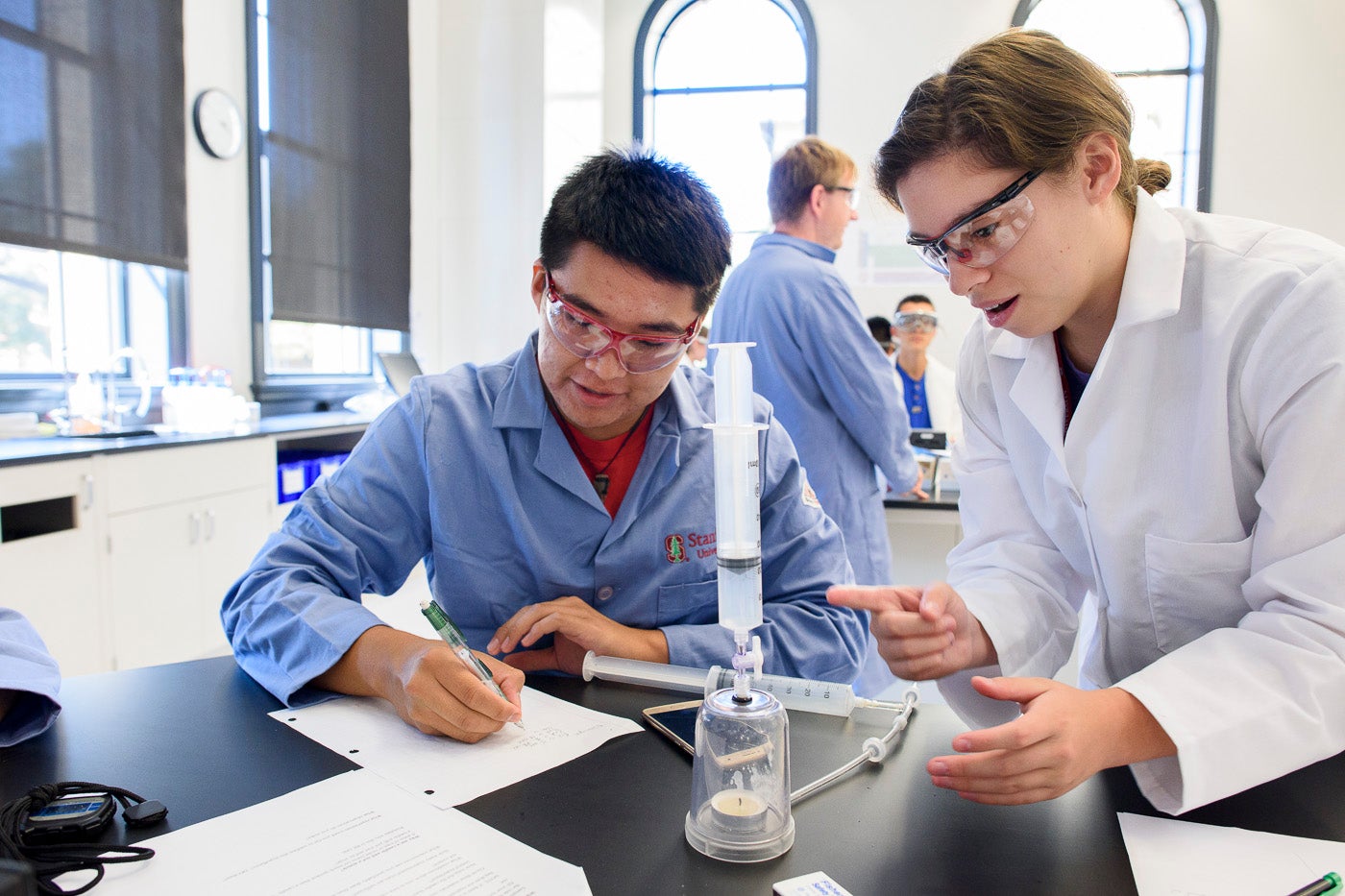Leland Scholars introduced to life on the Farm
The Leland Scholars Program helps ease the transition to Stanford for students who may be the first members of their families to attend college, come from low-income households or are graduates of high schools with limited curricular offerings.
Every time Ely Jay Nez gets out of class, he turns around for a moment to marvel at the building he has just left – for example, Lathrop Library near the Oval, the Sapp Center for Science Teaching and Learning in the Old Chemistry Building, Wallenberg Hall in the historic Main Quad.

Leland Scholars John Okhiulu and Bao Phan work together to test how different gases affect a lighted candle. (Image credit: L.A. Cicero)
“Every building here is so amazing,” said Nez, a member of the Navajo Nation of Arizona and one of 60 first-year students participating in the Leland Scholars Program, which began in early August and ends in early September. “Every day here is so amazing. I applied to Stanford because I wanted more for myself. Someone was listening to my prayers.”
Nez, who grew up in a small desert town near Monument Valley, said he has found the community he was seeking through the program, which helps ease the transition to university life for students who may be the first members of their families to attend college, come from low-income households or are graduates of high schools with limited curricular offerings.
“I never took chemistry, so everything I’m learning and talking about and seeing on the board in chemistry class is new to me,” Nez said. “I think I may want to go into a STEM field, so I wanted to get a taste of science. Here, the person sitting to my right or the person sitting to my left can point me in the right direction. Everyone here is so helpful. Everyone here is so nice. It’s like a home away from home.”
Stanford established the Leland Scholars Program in 2012 and invited 33 students to spend three weeks on campus. Last summer, thanks to a generous gift, the university increased enrollment 60 students, extended the program to four weeks and added writing classes. The Leland Scholars community is international, with four first-year students from Argentina, Ethiopia, Ghana and Rwanda.
Each year, the program attracts more applicants than it can accommodate. This year, nearly 150 incoming Stanford students applied to become Leland Scholars.
In mid-September, Nez and the rest of the students will return to campus and join the Class of 2021 for New Student Orientation, including the Opening Convocation Ceremony, a solemn and joyful tradition welcoming new students and their families to Stanford.
Getting a taste of life on the Farm
In the meantime, the Leland Scholars are getting a taste of the exciting academic, residential and social life that awaits them through a carefully crafted schedule of chemistry and writing classes, seminars, activities and trips.
They get “hands-on” experience in the lab, where they design their own experiments and learn data analysis techniques. They gather for study hall. They visit instructors during office hours. They attend late night discussions led by juniors and seniors – Leland Scholars known as “preceptors” who live with them in Soto House on the east side of campus and serve as activity planners, tutors, mentors and advisors. It’s a role one senior described as “resident assistants on steroids.”

Jennifer Schwartz Poehlmann (left), senior lecturer in chemistry, welcomes the Leland Scholars to their first lab at Stanford. (Image credit: L.A. Cicero)
The students earn 3 college credits: one for writing, one for chemistry and one for collaborating on research posters and participating in residential programs.
In writing class, each student completes an annotated bibliography on a topic of his or her choice, in preparation for writing an op-ed designed to “speak” to the audience of a publication of his or her choosing.
“The writing course introduces students to academic writing, and teaches them how to make thoughtful arguments that combine academic research with social and cultural relevance,” said Ashley Newby, one of several lecturers in the Program in Writing and Rhetoric who teach the Leland Scholars. “The students are encouraged to apply the skills and information they learned both in chemistry and writing to their poster projects.”
Jennifer Schwartz Poehlmann, a senior lecturer in chemistry who co-teaches the chemistry class, said students forge relationships with other first-year students, current Stanford students, instructors and faculty throughout the program.
“These are relationships that they know they can rely on when things inevitably get challenging during their time at Stanford,” she said. “They already have places to turn before they even walk in the door – and that’s really amazing.”
The summer session marks the beginning of a long-term relationship between Stanford and the students. During autumn and winter quarters of their first year, they will take weekly seminars and meet quarterly with Lourdes Andrade, the program’s associate director.
The program hosts speakers, events, chill-outs and outdoor events for the students throughout the year. In addition, the LSP Council – composed of Leland Scholars in every class – organizes events, including tailgate parties, movie screenings, brunches and dinners. Each year, the program holds a retreat for sophomores and juniors.
Chemistry class homework
At the beginning of one chemistry class, the Leland Scholars unfurled their homework – paper posters providing analogies for Avogadro’s number – and stuck them to the walls and columns of their classroom in Lathrop Library.
In response to a call for volunteers to share their analogies, three students walked over to a poster with hand-drawn images of a chubby puppy orbiting planet Earth. One of them read: “If Earth had a satellite that was a puppy with 6.023 x 1023 cells, it would be 600 times the volume of Haley’s Comet.”

Leland Scholars Ely Jay Nez and Lizbeth Gomez observe changes in a lit candle after introducing nitrogen into a sealed jar. (Image credit: L.A. Cicero)
The analogy generated appreciative murmurs, followed by applause.
“Who did the chocolate pyramid poster – I want to hear from you,” said Charlie Cox, a lecturer in the Chemistry Department, who co-teaches the class.
“Why?” one student called out in a laughing voice.
“Because I like chocolate,” Cox replied with a smile.
The poster, illustrated with a makeshift drawing of a pyramid with a chocolate bar resting on one side read: “With Avogadro’s number of chocolate bars, you decide to build your pyramids after the Great Pyramid of Giza. Lining the pyramids up side by side, you could reach the nearest star, Proxima Centauri, and come back to Earth 193,435 times.”
That poster, too, won admiring comments and applause.
“Each of these posters is very interesting and very cool,” Cox said, looking out at the students, who were sitting six to a table with hand-decorated place tags at each seat. “I’m going to pull a few and use them in my slides next year.”
Cox then introduced guest speaker Provost Persis Drell, who had arrived at the tail end of the poster presentation and was waiting to address the students.
‘You bestow honor on us’
After urging the students to roll their chairs to the front of the room, Drell asked and answered the question on many of their minds: What the heck is the provost?
“I work very closely with the president – we’re a team,” she said. “But I am responsible for all academic things. I am responsible for all the faculty. I’m responsible for all the students. So I care a lot about you. I care a lot about your educational experience. I care a lot about academic quality here at Stanford. I care about athletics. I care about residential dining. I care about almost everything that will be part of your life while you’re here at Stanford.”
Drell told the students that her job was to help them be successful at Stanford.
“By the way, I just want to add something here,” she said. “What is success? Success is not that you become what somebody else thinks you ought to become. Success is that you develop into the person that you want to become.”
“Every single one of you got into Stanford because of who you are. … It is not that we bestow honor on you by accepting you into Stanford. You bestow honor on us by coming to Stanford.”
—Provost Persis Drell
Drell shared personal anecdotes about her college days, from the “chance course” at Wellesley College that changed the course of her life to the put-downs she heard in graduate school, where she was the only woman in her physics class.
“I had people tell me, ‘You got that fellowship because you’re a girl,’ and ‘You got into Berkeley because you’re a girl,’” Drell recalled. “I wasn’t so self-confident back then that I could say, ‘No, I got in because I’m me.’”
Looking slowly around the semicircle of upturned faces, Drell said Stanford had carefully selected each one of them to join its community of scholars.
“Every single one of you got into Stanford because of who you are and the characteristics you have displayed up to this point,” she said. “As Leland Scholars, you displayed a particular set of characteristics that I especially admire. I am honored that you are here. It is not that we bestow honor on you by accepting you into Stanford. You bestow honor on us by coming to Stanford. And don’t let anyone take that away from you.”
For more information about the Leland Scholars Program, contact Lourdes Andrade, associate director, at lourdes.andrade@stanford.edu.
